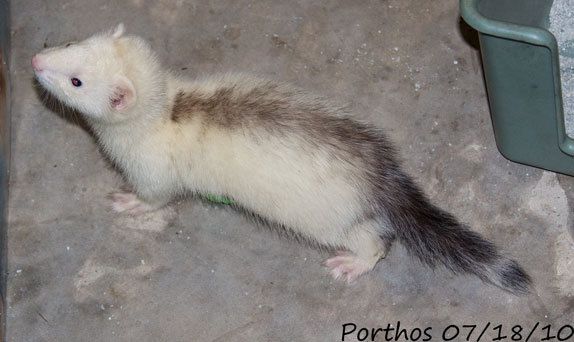Striped White Ferrets are quite unique among ferrets. They have a white coat and a dark-colored line that goes from their back to their tail. You also don’t have to worry about their health issues as they don’t suffer from any lack of pigmentation. These ferrets are simply white or a creamy color.
There are various options on the market, including 8 colors and more than 12 shades and patterns you can choose from. But in this article, we’ll talk about how to take care of Striped White Ferrets and what are their needs.

What do Striped White Ferrets Look Like?
Striped White Ferrets are known for their dark line that goes from various places to their tail. It can begin from the top of their heads, shoulders, or even lower back. It’s a very simple coat but it makes the ferret look a lot more interesting.
Since they are white, they can have pink or dark red eyes, and the nose is typically either pink or black. The striped line typically ends almost in the tip of the tail, but the tip of the tail still remains white. Some Striped White Ferrets have a more pigmented line that ends right at the tip of the tail, while others have a more light and severed line.
Typically, the legs are white and the only color this ferret has is in the striped line. But you can also find Striped White Ferrets that have a more creamy or ashy color on the legs as well.
Grooming Ferret Coats – Brushing and Bathing
Grooming a ferret can seem a bit overwhelming at first, especially since they’re not as obedient and cooperative as cats and dogs. They have a lot of energy and can’t stand in one place for too long no matter what treats you’re trying to bribe them with.
This means that whatever grooming procedure you do, it has to be fast and efficient. You also need to get used to the fact that the first few grooming sessions will be very annoying to your ferret, even traumatic to some. But with enough patience, you can make them cooperate with you and some might even grow to enjoy it.
The brushing process depends on whether your ferret has short, long, or very long fur. If its coat is short, you will be able to get away with brushing it quickly once a week and twice a week during the shedding season.
Long and very long coats are a bit harder to groom as it takes a lot of time and patience to untangle everything, time and patience that your ferret doesn’t have. This is where you need to use your ferret’s favorite treats and a good brush that helps you work as fast as possible.
If you have an exotic pet shop nearby, you should be able to find a ferret brush very quickly. But if you don’t, you can go to a regular pet shop and get a short-bristled brush made for kittens. The first few times you might have to allow the ferret to smell and check out the brush before you use it on them as they tend to get scared of unknown objects.
Once the ferret knows that the brush is for and doesn’t arch its body to avoid it, you can start brushing the coat with quick but exact moves. You should start from their shoulders and go in the same direction the hair grows. Don’t be very fast as the brush can meet a bad entangled spot that hurts the ferret when brushed with force.
It’s ideal to be done with the brushing in less than five minutes as it’s likely the ferret won’t last any longer. The first few times will be unpleasant for both you and the ferret, but as you learn how to do it better the ferret will start to get used to it. This will make it calmer and you can brush it without trying to stop it from escaping at the same time.
Bathing can be very harmful to ferrets if it’s done very often and it can even have the exact opposite effect than what you hoped for. You should stick to bathing your ferret once every two months or just whenever they get into something that can’t be wiped with a towel.
Frequently Asked Questions:
Are Striped White Ferrets difficult to care for?
Striped White Ferrets are typically clean creatures and with a few grooming sessions a week you should be able to keep the animal looking and smelling fresh.
